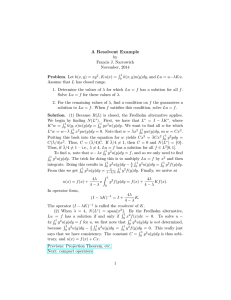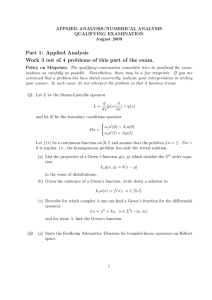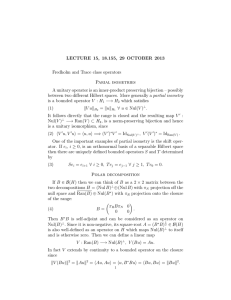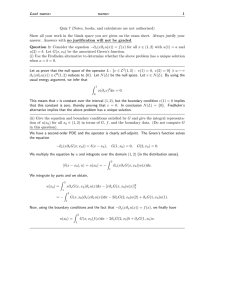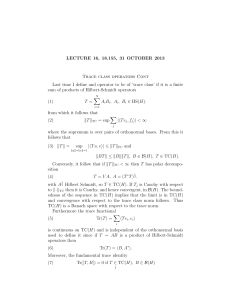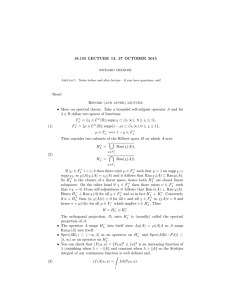LECTURE 20, 18.155, 22 NOVEMBER 2011
advertisement
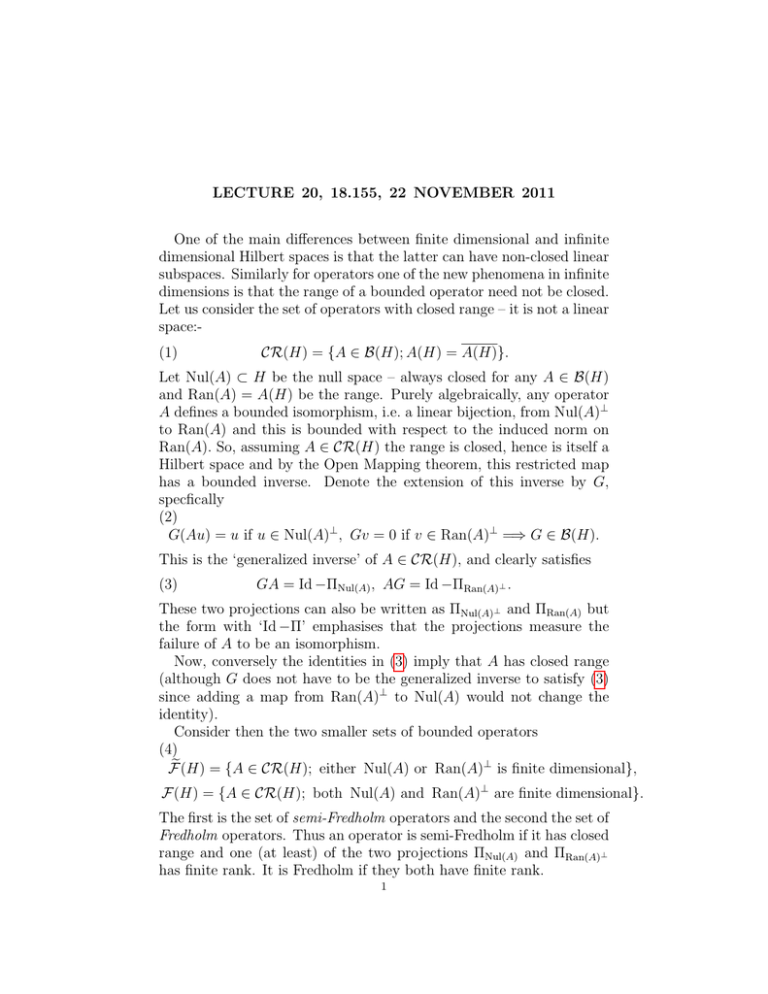
LECTURE 20, 18.155, 22 NOVEMBER 2011
One of the main differences between finite dimensional and infinite
dimensional Hilbert spaces is that the latter can have non-closed linear
subspaces. Similarly for operators one of the new phenomena in infinite
dimensions is that the range of a bounded operator need not be closed.
Let us consider the set of operators with closed range – it is not a linear
space:(1)
CR(H) = {A ∈ B(H); A(H) = A(H)}.
Let Nul(A) ⊂ H be the null space – always closed for any A ∈ B(H)
and Ran(A) = A(H) be the range. Purely algebraically, any operator
A defines a bounded isomorphism, i.e. a linear bijection, from Nul(A)⊥
to Ran(A) and this is bounded with respect to the induced norm on
Ran(A). So, assuming A ∈ CR(H) the range is closed, hence is itself a
Hilbert space and by the Open Mapping theorem, this restricted map
has a bounded inverse. Denote the extension of this inverse by G,
specfically
(2)
G(Au) = u if u ∈ Nul(A)⊥ , Gv = 0 if v ∈ Ran(A)⊥ =⇒ G ∈ B(H).
This is the ‘generalized inverse’ of A ∈ CR(H), and clearly satisfies
(3)
GA = Id −ΠNul(A) , AG = Id −ΠRan(A)⊥ .
These two projections can also be written as ΠNul(A)⊥ and ΠRan(A) but
the form with ‘Id −Π’ emphasises that the projections measure the
failure of A to be an isomorphism.
Now, conversely the identities in (3) imply that A has closed range
(although G does not have to be the generalized inverse to satisfy (3)
since adding a map from Ran(A)⊥ to Nul(A) would not change the
identity).
Consider then the two smaller sets of bounded operators
(4)
e
F(H)
= {A ∈ CR(H); either Nul(A) or Ran(A)⊥ is finite dimensional},
F(H) = {A ∈ CR(H); both Nul(A) and Ran(A)⊥ are finite dimensional}.
The first is the set of semi-Fredholm operators and the second the set of
Fredholm operators. Thus an operator is semi-Fredholm if it has closed
range and one (at least) of the two projections ΠNul(A) and ΠRan(A)⊥
has finite rank. It is Fredholm if they both have finite rank.
1
2
LECTURE 20, 18.155, 22 NOVEMBER 2011
e
In all three cases F(H) ⊂ F(H)
⊂ CR(H), composition on the right
or left by a bounded invertible operator maps these sets into themselves.
Note that if A ∈ B(H) has range with a closed complement – meaning that there is a closed subspace F ⊂ H such that F ∩ Ran(A) = {0}
but H = F + Ran(A) – then Ran(A) is in fact closed and A ∈ CR(H).
Indeed, the map F ⊕ H 3 (f, u) 7−→ f + Au is clearly bounded and
surjective, so from the discussion above (meaning the open mapping
theorem) has a bounded generalized inverse G. If vn ∈ Ran(A) converges to v ∈ H then Gvn = (fn , un ) → (f, u) but fn = 0 since
F ∩ Ran(A) = {0} and hence Au = v and Ran(A) is closed. In particular if a bounded linear map has range with a finite dimensional
complement then it is semi-Fredholm. Note that it is not true (maybe
you need to worry about the truth of the Axiom of Choice here) that
a general subspace with a finite dimensional complement is closed. A
non-trivial, but non-continuous linear functional has null space which
is not closed but does have a 1-dimensional complement (spanned by
any vector not in the null space). So it is important here that we are
considering the range of a bounded operator – which is not an arbitrary
linear subspace.
It is very convenient in the subsequent discussion to have a somewhat
coarser characterization of Fredholm operators.
Lemma 1. An operator A ∈ B(H) is Fredholm if and only if it has
both a left and a right parameterix, in the sense that there are operators
BR and BL ∈ B(H) such that
(5)
ABR = Id −KR , KR ∈ K(H),
BL A = Id −KL , KL ∈ K(H).
Here a parametrix (modulo an ideal, in this case the compact operators)
is a (one-sided in this case) inverse modulo the ideal, i.e. with a ‘error’
term which is in the ideal.
Proof. That (5) can be arranged for a Fredholm operator is immediate,
since the generalized inverse gives (5) in the much stronger form (3)
with KR and KL the finite rank projections onto the null space and
the orthocomplement of the range.
The converse, that (5) holds follows from special case that A =
Id −K where K ∈ K(H) is Fredholm. Clearly this satisfies (5) with
BR = BL = Id . Conversely, once we know that each operator Id −K
is Fredholm where K ∈ K(H) we see that the operators on the right
in (5) are Fredholm. In particular Id −KR has finite dimensional null
space and Id −KL has closed range of finite codimension. However the
LECTURE 20, 18.155, 22 NOVEMBER 2011
3
two identities in (5) imply that
(6)
Nul(A) ⊂ Nul(Id −KR ), Ran(A) ⊃ Ran(Id −KL ).
Thus the null space of A must be finite dimensional, since it is contained in a finite-dimensional space and Ran(A) must have a finite
dimensional complement since it contains a subspace with finite dimensional complement. In any case, Ran(A) contains a closed linear
subspace of finite codimension which ensures that it too is closed.
Thus we are reduced to showing that Id −K is Fredholm where K ∈
K(H). This follows from the decomposition discussed earlier that
(7)
Id −K = (Id −B1 )(Id −D)(Id −B2 ), kB1 k < 1, kB2 k < 1
and where ΠN DΠN = D for the projection onto the span of the first N
elements of an orthonormal basis. Thus Id −D has finite dimensional
null space, since it is contained in the range of ΠN and finite dimensional complement to the range, since the range contains the range of
Id −ΠN . Then the general case follows from (7) since the outer factors
are invertible.
Although this result is stated in terms of the existence of a separate
right and left parametrix, as in (5), it follows directly that, once both
exist, each is actually a two-sided parametrix in the same sense. It
is useful to have this a little more abstractly so that it coverse other
ideals that K(H).
Lemma 2. If A is an associative algebra, I ⊂ A is a two-sided
ideal and A ∈ A has left and right parametrices, BL , BR ∈ A, so
Id −ABR ∈ I and Id −BL A ∈ I then BR − BL ∈ I and each is a
two-sided parametrix modulo I.
This is just the uniqueness of inverses in the associative algebra A/I.
Proof. By assumption
BL = BL (Id −ABR +ABR ) = BL ABR +I1 = (BL A−Id)BR +BR +I1 = BR +I1 −I2
where I1 = BL (Id −BR ) ∈ I and I2 = (Id −BL A)BR ∈ I. Adding
an element of I to a left or right parametrix gives another, so the
conclusions follow.
Proposition 1. The Fredholm operators form an open set in B(H)
which is closed under composition and adjoints; the image under a
Fredholm operator of a closed subspace is closed. The semi-Fredholm
operators for an open and dense set closed under composition with Fredholm operators and adjoints (and the operators with closed range are
dense).
4
LECTURE 20, 18.155, 22 NOVEMBER 2011
Proof. Suppose A ∈ F(H). By definition it has a generalized inverse
and hence a two-sided parametrix, B ∈ B(H), modulo compact operators. Set KR = Id −AB and KL = Id −BA by assumption both in K.
Now, suppose E ∈ B(H) and kEk < 1/kBk. Then
(8)
(A+E)B = AB+EB = (Id +EB)−KR , B(A+E) = BA+BE = (Id +BE)−KL .
The norm assumption implies that Id +EB and Id +BE are invertible
so(8) can be written
(9)
(A+E)B(Id +EB)−1 = Id −KR0 , (Id +BE)−1 B(A+E) = Id −KL0 , KR0 = KR (Id +EB)−1 , KL0 =
showing that B(Id +EB)−1 is a right parametrix and (Id +BE)−1 B is
a left parametrix. Thus A + B is Fredholm and F(H) ⊂ B(H) is open.
If B is a two-sided parametrix for A then B ∗ is a two-sided parametrix for A∗ . If A1 , A2 ∈ F(H) have parametrices B1 and B2 then B2 B1
is a two-sided parametrix for A1 A2 thus A1 A2 ∈ F(H).
Still assuming A ∈ F(H), if V ⊂ H then AV = A(V + Nul(A)) and
if V is closed, so is V + Nul(A) as the sum of a closed and a finitedimensional subspace. Thus we can replace V by its orthocomplement
in V + Nul(A) to Nul(A) – a new closed subspace with the same range
and now orthogonal to Nul(A). Then if fn ∈ AV converges un = Gfn ∈
V converges to u ∈ V, where G is the generalized inverse, and lim fn =
Av ∈ AV.
e
From this the fact that the composite of an element of F(H)
and
e
an element of F(H) is in F(H)
follows readily as does the fact that
CR(H) ◦ F(H) ⊂ CR(H) and F(H) ◦ CR(H) ⊂ CR(H).
e
So, it remains to show that F(H)
is open and dense. Since we
have already shown that the Fredholm operators are open, it suffices
e
to consider a general point in F(H)
\ F(H). Consider the case where
e
A ∈ F(H) and the range has finite codimension but the null space
is infinite dimensional. Thus the generalized inverse, G of A satisfies
AG = Id −Π where Π is finite rank. As discussed above for Fredholm
operators, if kBkkGk < 1 then (A + B)G = (Id +BG) − Π and
(10)
(A + B)G(Id +BG)−1 = Id −Π(Id +BG)−1
is a right parametrix for A + B modulo finite rank. Thus A + B has
range of finite codimension – since it contains the range of the Fredholm
e
operator Id −Π(Id +BG)−1 . The other case is similar, so F(H)
is open.
e
Finally, to see that F(H) is dense, we can use the polar decom1
position. Thus if B ∈ B(H) then B = U D where D = (B ∗ B) 2 is
non-negative and self-adjoint and U is a partial isometry from Ran(D)
LECTURE 20, 18.155, 22 NOVEMBER 2011
5
to Ran(B). Let ΠD be the orthogonal projection onto Ran(D) then
D = D + ΠD is stricly positive and self-adjoint, and hence is invertible, as an operator on ΠD and D (Id −ΠD ) = 0. Thus B = U D has
⊥
range precisely Ran(B) and null space precisely Ran(D) = Nul(D).
Thus D ∈ CR(H) and we have shown the density of CR(H) in B(H).
If D is not semi-Fredholm then both Ran(B)⊥ and Nul(B) must be
infinite dimensional. Hence, as separable Hilbert spaces, they are unitarily equivalent with P : Nul(D) = Nul(B) −→ Ran(B)⊥ a unitary
isomorphism between them. It follows that for small , D + P is
invertible.
If A ∈ F(H) the index is defined to be
(11)
ind(A) = dim Nul(A) − dim Ran(A)⊥ ∈ Z.
Proposition 2. Suppose A ∈ F(H) and B is a two-sided parametrix
modulo trace class operators, then [A, B] ∈ C(H) and
(12)
ind(A) = Tr([A, B]).
Proof. A two-sided parametrix modulo trace class operators certainly
exists, since the generalized inverse is one. In fact from Lemma 2
it follows that these are precisely the operators in B ∈ G + C(H) i.e.
B = G+T, T ∈ C(H). The commutator [A, B] = (Id −BA)−(Id −AB)
is certainly trace class and
(13)
[A, G] = (Id −GA)−(Id −AG) = ΠNul(A) −ΠRan(A)⊥ =⇒ Tr([A, G]) = Tr(ΠNul(A) )−Tr(ΠRan(A)⊥ ) =
since the trace of a finite rank projection is the dimension of the image.
In general consider B = G + T with T ∈ C(H). Then
(14)
[A, B] = [A, G] + [A, T ] =⇒ Tr([A, B]) = Tr([A, G]) = ind(A)
since the trace vanishes on the commutator of a bounded and a traceclass operator.
From this ‘analytic’ formula for the index we easily deduce:Proposition 3. The index is constant on components of F(H) and is
log-multiplicative in the sense that
(15)
ind(A1 A2 ) = ind(A1 )+ind(A2 ) if A1 , A2 ∈ F(H), ind(A∗ ) = − ind(A).
Note also that if B is a two-sided parametrix modulo compact operators
for A ∈ F(H) then B ∈ F(H) and ind(B) = − ind(A).
Proof. If A ∈ F(H) then we know that if G is its generalized inverse
then for kBkkGk < 1, A + sB is Fredholm for |s| ≤ 1 and Gs =
6
LECTURE 20, 18.155, 22 NOVEMBER 2011
G(Id +sBG)−1 is a right parametrix for A + sB with finite rank, hence
trace class, error. Thus in fact Gs is a two-sided parametrix relative to
the trace class ideal. Using the computations above,
(A + sB)G(Id +sBG)−1 = Id −ΠNul(A) (Id +sBG)−1 = Id −Ks ,
(16)
(Id +sGB)−1 G(A + sB) = Id −(Id +sGB)−1 ΠRan(A)⊥ ,
(Id +sGB)−1 G = G(Id +sBG)−1
(where the last identity follows from G(Id +sBG) = (Id +sGB)G)
shows that [A + sB, G(Id +sBG)−1 ] is continuous (in s) with respect
to the trace-class norm. Thus in fact
(17)
ind(A + sB) = Tr([A + sB, G(Id +sBG)−1 ]) ∈ C 0 ([0, 1])
but, being integer valued, it is therefore constant.
Thus the index is locally constant on the open set F(H) where it is
defined and therefore constant on components.
Now, if Ai are Fredholm with generalized inverses Gi , i = 1, 2 then
G2 G1 is a parametrix modulo finite rank (and hence trace class) for
A1 A2 . If we write Ai Gi = Id −Ti , Gi Ai = Id −Si , where the Ti and Si
are finite rank, and hence trace class, then
G2 G1 A1 A2 = G2 A2 − G2 S1 A2 = Id −S2 − G2 S1 A2 ,
(18)
A1 A2 G2 G1 = A1 G1 − A1 T2 G1 = Id −T1 − A1 T2 G1
gives the parametrix conditions and shows that
(19)
ind(A1 A2 ) = Tr([G2 G1 , A1 A2 ]) = Tr(S2 + G2 S1 A2 − T1 − A1 T2 G1 )
= Tr(S2 + S1 A2 G2 − T1 − G1 A1 T2 ) = Tr(S2 + S1 − S1 T2 − T1 − T2 + S1 T2 )
= Tr(S1 − T1 ) + Tr(S2 − T2 ) = ind(A1 ) + ind(A2 ).
Now, we can easily see that the index is surjective. Indeed, on a
separable Hilbert space, take an orthonormal basis and consider the
shift operators defined by linear extension from their action on the
bases:(20)
Sei = ei+1 , ∀ i, S ∗ ej = ej−1 , j ≥ 1, S ∗ e1 = 0.
∗
Clearly S is injective with range e⊥
1 and S is surjective, with null space
∗
spanned by e1 . Thus ind(S) = −1, ind(S ) = 1. Taking powers gives a
Fredholm operator of each index. Next we show that the index actually
labels the components of F(H).
Proposition 4. Any two Fredholm operators of the same index can be
connected by a curve in F(H).
LECTURE 20, 18.155, 22 NOVEMBER 2011
7
Proof. If A1 and A2 both have index k ∈ Z then A∗1 A2 has index zero.
If we connect A∗1 A2 to Id by a curve C(t) in the Fredholm operators of
index zero then A1 C(t) connects A1 A∗1 A2 to A1 . Thus it suffices to show
that A1 A∗1 A2 can be connected to A2 . The curve ((1 − )A1 A∗1 + Id)A2
does this.
Thus we are reduced to the case of index 0, connecting A to Id .
Since the index is zero, the null space of A has the same dimension
as the orthocomplement of the range. These finite dimensional spaces
are therefore isomorphic and we can perturb A to A + tU where U :
Nul(A) −→ Ran(A)⊥ is such an isomorphism. This shows that A can
be connected to an invertible operator – in fact that the invertible
operators are dense in the Fredholm operators of index zero. Thus
to complete the proof we only need the next result on the group of
invertible operators.
Lemma 3. The group, GL(H), of invertible operators on a separable
Hilbert space H is connected (in the norm topology).
In fact GL(H) is contractible – this is Kuiper’s Theorem.
Proof. We only need connect a given invertible operator B to the identity. The polar decomposition B = U D gives a unitary operator U,
so U ∗ U = U U ∗ = Id and a stricly positive self-adjoint operator D.
The curve ((1 − t)D + t Id), t ∈ [0, 1] consists of invertible self-adjoint
operator and this allows B to be connected to U. Thus we only need
to show that a unitary operator can be connected to the identity. This
however represent progress since
1
i
(21) U = A1 + iA2 , A1 = (U + U ∗ ), A2 = (U − U ∗ ), [A1 , A2 ] = 0
2
2
where the commutation property follows from the unitarity. Let π be
the spectral projection on (−∞, 0] for A2 . Thus π is obtained from the
functional calculus for the self-adjoint operator A2 and it commutes
with any operator with which A2 commutes, so [π, A1 ] = 0. Moreover,
hA2 πu, ui ≤ 0 and hA2 (Id −π)u, ui ≥ 0 for all u ∈ H. This allows us
deform U into
(22)
Ut = A1 +iA2 (t), A2 (t) = ((1−t)A2 π−tπ)+((1−t)A1 (Id −π)+t(Id −π), t ∈ [0, 1].
This stays invertible (can easily be made unitary if desired) since for
instance Ut∗ Ut = Ut Ut∗ = A21 +((1−t)A2 π+tπ)2 +((1−t)A1 (Id −π)−tπ)2
is certainly invertible. This connects U to A2 + iπ − i(Id −π) and then
the curve sA2 + iπ − i(Id −π) connects this to iπ − i(Id −π) and finally
the curve ei(1−t) π − e−i(1−t) (Id −π) connects this to the identity.
8
LECTURE 20, 18.155, 22 NOVEMBER 2011
So, why be interested in Fredholm operators anyway? Well, the first
reason is that they occur often enough – elliptic differential opertors on
compact manifolds for example. The important property of course is
that they are ‘nearly invertible’. The stability of the index as observed
above means that it is highy computable, although the computations
are not trivial and often have a significant topological component, as
in the celebrated Atiyah-Singer theorem and its many generalizations.
What do you get if you know the index of a Fredholm operator? Of
course the main property is the essentially trivial observation:(23)
A ∈ F(H) =⇒ dim Nul(A) ≥ ind(A), dim Ran(A)⊥ ≥ − ind(A).
So, showing that ind(A) > 0 proves that the operator in question has
null space.

